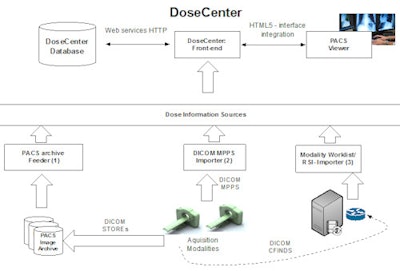
To help tackle the challenging task of monitoring cumulative patient radiation dose from imaging studies across institutions, a Portuguese research team has developed a Web-based system that automatically extracts, processes, and analyzes dose data.
The software, called Dose Center, integrates with PACS archives and workstations to provide users with cumulative dose reports, including simulation of radiation dose expected in upcoming imaging studies. Users can perform dose analysis on both a patient and population level, said Dr. Luís Bastião Silva of the University of Aveiro.
Silva shared the experiences of the university's dose monitoring initiative during a presentation at the recent Computer Assisted Radiology and Surgery (CARS) conference in Barcelona, Spain. He and colleagues from the University of Aveiro collaborated with software developer BMD Software on the project.
Motivation
Systematic monitoring of radiation dose would provide performance control, protocol optimization, correction of wrong practices, and be compliant with European legislation. However, dose monitoring should be performed for each patient, and should include integration with RIS/PACS to allow data analysis and continuous monitoring, Silva said.
Many imaging devices today such as CT scanners are already producing dose reports, but few vendors support the ability to view data from a population perspective. In addition, these tools are more optimized to clinical research, are time-consuming, and are not focused on the patient, Silva said.
"They do not provide answers to typical questions from physicians," he noted.
Furthermore, there's a lack of simulation of cumulative dose based on planned studies and a lack of integration with data sources and information systems, Silva said. Cross-institutional support is also frequently missing.
Dose Center
Dose Center offers continuous radiation dose monitoring capability and is fully integrated with PACS data sources, featuring automatic extraction and processing of examination dose data. Its use of HTML5 and JavaScript enables Dose Center to run on multiple platforms.
"It's fast, simple, and effective," Silva said.
Dose Center provides users with an aggregated view of DICOM metadata, pixel data via optical character recognition technology, and DICOM Radiation Dose Structured Reports. It also enables dose analysis at a patient or population-centric scope.
Effective dose and cumulative dose reports are available -- calculated either from organ doses or from diagnostic reference levels (DRLs) using conversion factors -- and can be viewed on intuitive dashboards for comparative analysis, Silva said. Automatic alerts are given when patient safety could be compromised. Dose simulations support three different recommendations from the International Commission on Radiological Protection (ICRP).


Dose Center allows users to view cumulative dose for patients, including simulation of the dose patients will receive from upcoming studies. All images courtesy of Dr. Luís Bastião Silva.
Patient-centric dose monitoring
Dose Center tracks patient history and provides alerts based on commonly accepted DRLs, Silva said. Cumulative dose is shown on a cumulative dose progress bar, including automatic simulation of the dose the patient is expected to receive based on the DICOM Modality Worklist scheduler.
 Dose Center architecture.
Dose Center architecture.The university's Dicoogle plug-in is used to extract dose information from the PACS archive feeder and send it to Dose Center. When necessary and in multisite environments, the monitoring system combines heterogeneous dose data from multiple imaging archives and can measure impact by time frames or groups of people affected by the dose workflow, the researchers described in an article published online on 27 May in the Journal of Digital Imaging.
"This is possible due to the system's federative nature: in each participant domain, dose information is collected and sent to a central aggregator that provides a centralized view of the information," the authors wrote. "This enables audit studies focusing on site productivity and dose statistics of the selected study groups."
While radiation indicators are not often measured today due to a lack of access to these data as well as an absence of data normalization processes to account for data being stored in different formats or nomenclatures, the group's proposed aggregation software provides a baseline system for gathering and normalizing dose metadata presented in DICOM objects, according to the group.
"Therefore, the presented system provides the means to effectively monitor dose values at several sites, enabling benchmarking and, as a consequence, continuously improving the quality of care provided to patients," they wrote.
Dose Center is currently being tested in a pilot with one regional hospital and three geographically distributed locations. Clinicians can access cumulative patient dose across institutions, and operators/technicians can easily access patient dose history from each location, Silva said.



















